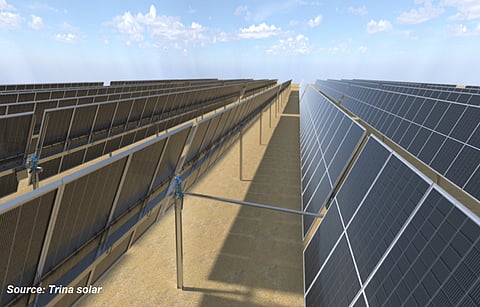

The progress made in the solar trackers segment has been remarkable within 1 year between our 2 market survey published on solar tracker technology, the latest in Dec. 2022. Actually, several things have worked in its favor. First and foremost is the wider adoption of the bifacial technology. Trackers as the mounting structure and bifacial module technology are a perfect match to increase the power yield (that's why we organized a combined Bifacial and Solar Trackers 2022 Virtual Conference – presentations see here). This combination makes also economic sense despite trackers being much more sophisticated, complex and also expensive than fixed tilt ground-mounting systems. And the trend to bifacial modules in utility scale solar will continue, in particular with high-efficiency cells that offer higher bifaciality than today's PERC technology.
While high module prices mainly due to the shortage in silicon supply have been an argument for trackers to help extract more power from the same PV device in the first half of 2022, due to their premium compared to standard racking prices, trackers as a segment also have faced quite some challenges during this period. Supply disruptions of raw materials that hit several global industrial segments also affected trackers in the form of higher steel prices, which is the main cost for the product.
The huge potential for solar trackers on their radar – and the urge to adapt to developments in the module segment, a lot of products updates and innovations can be seen from tracker companies. The key topics in 2021 were reliability, resistance against wind loads, wind tunnel tests, accommodating larger module formats etc., as we outlined in our last survey. Now it seems that several of these areas have been addressed, at least by the leading suppliers. And these innovations and improvements are coming about in two parallel paths – hardware and software – and it goes without saying that bifacial-focused optimizations are an integral part of any development.
On the hardware front, the key point of focus is making trackers that can follow the terrain. Not only are developments of large utility-scale plants getting increasingly challenging on flat lands – as both PV power plants get more and larger and opposition of locals is increasing as well. Land grading increasingly is also facing challenges from a permitting and legislations viewpoint that sometimes even jeopardize entire projects. Higher degrees of earth moving and grade may also lead to higher costs and trackers are associated with the utility segment of PV, where every penny matters. Terrain modulations can be addressed partly by increasing the length of the piles, which also increases the costs. The first companies have already come up with innovative tracker solutions that can follow the slopes of the terrain, which considerably reduce grading work if not eliminate it completely. It can be safely assumed that the others will follow this path as well (see Tracking Also On Terrains).
In parallel, manufacturers are adding value to their solutions through software. The use of high-end algorithms, AI and advanced machine learning is the next hot topic in the industry, and their applicability to trackers multifold. These advanced algorithms improve power generation in highly diffused irradiance conditions, a function that is very beneficial when a plant is based on bifacial modules, and moreover needed when expanding into less sunny regions. The algorithms are also used for backtracking to avoid row-to-row shading, especially during sunrise and sunset. Advanced AI based meteorological data mapping for the plant's location is used to guide the tracker control system to take appropriate action in adverse weather conditions (see Intelligent Solar Trackers).
Most manufacturers are working on a software solution of their own, if not having already released it to market, but the path ahead is a long one. Several of them have a clear roadmap towards achieving their goals of launching highly integrated and sophisticated control systems. The industry seems to have taken to the use of AI and machine learning in developing algorithms. The day where trackers deliver significant improvement energy yields even in suboptimal conditions for standard PV might not be too far.
However, 2023 should turn into a more exciting year for solar trackers – triggered not only by climate change but also the global energy crises, demand for solar will be gigantic. And with logistics prices having normalized and steel prizes having come down as well (even if somewhat up in recent months), the tracker segment seems well prepared.
